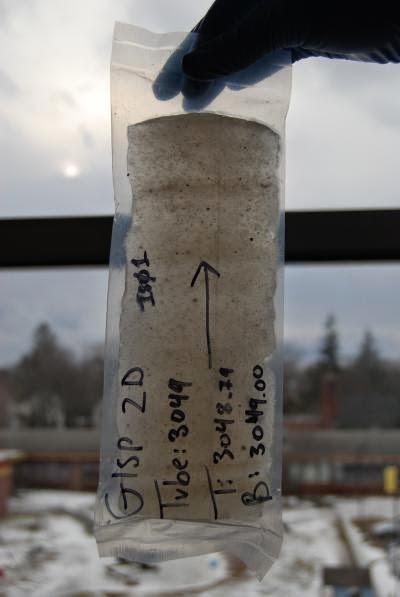
Glaciers are commonly thought to work like a belt sander. As they move over the land they scrape off everything—vegetation, soil, and even the top layer of bedrock. So scientists were greatly surprised to discover an ancient tundra landscape preserved under the Greenland Ice Sheet, below two miles of ice.
“We found organic soil that has been frozen to the bottom of the ice sheet for 2.7 million years,” said University of Vermont geologist Paul Bierman—providing strong evidence that the Greenland Ice Sheet has persisted much longer than previously known, enduring through many past periods of global warming.
He led an international team of scientists that reported their discovery on April 17 in the journal Science.
Greenland is a place of great interest to scientists and policymakers since the future stability of its huge ice sheet—the size of Alaska, and second only to Antarctica—will have a fundamental influence on how fast and high global sea levels rise from human-caused climate change.
“The ancient soil under the Greenland ice sheet helps to unravel an important mystery surrounding climate change,” said Dylan Rood a co-author on the new study from the Scottish Universities Environmental Research Centre and the University of California, Santa Barbara, “how did big ice sheets melt and grow in response to changes in temperature?”
The new discovery indicates that even during the warmest periods since the ice sheet formed, the center of Greenland remained stable; “it’s likely that it did not fully melt at any time,” Vermont’s Bierman said. This allowed a tundra landscape to be locked away, unmodified, under ice through millions of years of global warming and cooling.
“The traditional knowledge about glaciers is that they are very powerful agents of erosion and can effectively strip a landscape clean,” said study co-author Lee Corbett, a UVM graduate student who prepared the silty ice samples for analysis. Instead, “we demonstrate that the Greenland Ice Sheet is not acting as an agent of erosion; in fact, at it’s center, it has performed incredibly little erosion since its inception almost three million years ago.”
Rather than scraping and sculpting the landscape, the ice sheet has been frozen to the ground, “a refrigerator that’s preserved this antique landscape,” Bierman said.
The scientists tested seventeen “dirty ice” samples from the bottommost forty feet of the 10,019-foot GISP2 ice core extracted from Summit, Greenland, in 1993. “Over twenty years, only a few people had looked hard at the sediments from the bottom of the core,” Bierman said. From this sediment, he and a team at the University of Vermont’s Cosmogenic Nuclide Laboratory extracted a rare form of the element beryllium, an isotope called beryllium-10. Formed by cosmic rays, it falls from the sky and sticks to rock and soil. The longer soil is exposed at Earth’s surface, the more beryllium-10 it accumulates. Measuring how much is in soil or a rock gives geologists a kind of exposure clock.
The researchers expected to only find soil eroded from glacier-scoured bedrock in the sediment at the bottom of the ice core. “So we thought we were going looking for a needle in haystack,” Bierman said. They planned to work diligently to find vanishingly small amounts of the beryllium—since the landscape under the ice sheet would have not been exposed to the sky. “It turned out that we found an elephant in a haystack,” he said; the silt had very high concentrations of the isotope when the team measured it on a particle accelerator at Lawrence Livermore National Laboratory.
“On a global basis, we only find these sorts of beryllium concentrations in soils that have developed over hundreds of thousands to millions of years,” said Joseph Graly, who analyzed the beryllium data while at the University of Vermont.
The new research, supported by funding from the National Science Foundation, shows that “the soil had been stable and exposed at the surface for somewhere between 200,000 and one million years before being covered by ice,” notes Ben Crosby, a member of the research team from Idaho State University.
To help interpret these unexpected findings, the team also measured nitrogen and carbon that could have been left by plant material in the core sample. “The fact that measurable amounts of organic material were found in the silty ice indicates that soil must have been present under the ice,” said co-author Andrea Lini at the University of Vermont—and its composition suggests that the pre-glacial landscape may have been a partially forested tundra.
“Greenland really was green! However, it was millions of years ago,” said Rood, “Greenland looked like the green Alaskan tundra, before it was covered by the second largest body of ice on Earth.” To confirm their findings about this ancient landscape, the researchers also measured beryllium levels in a modern permafrost tundra soil on the North Slope of Alaska. “The values were very similar,” said Bierman, “which made us more confident that what we found under Greenland was tundra soil.”
Many geologists are seeking a long-term view of the history of the Greenland Ice Sheet, including how it moves and has shaped the landscape beneath it—with an eye toward better understanding its future behavior. It’s 656,000 square miles of ice, containing enough water, if fully melted, to raise global sea levels twenty-three feet—”yet we have very little information about what is happening at the bed with regards to erosion and landscape formation,” said Corbett.
What is clear, however, from an abundance of worldwide indicators, is that global temperatures are on a path to be “far warmer than the warmest interglacials in millions of years,” said Bierman. “There is a 2.7-million-year-old soil sitting under Greenland. The ice sheet on top of it has not disappeared in the time in which humans became a species. But if we keep on our current trajectory, the ice sheet will not survive. And once you clear it off, it’s really hard to put it back on.”
Note : The above story is based on materials provided by University of Vermont










